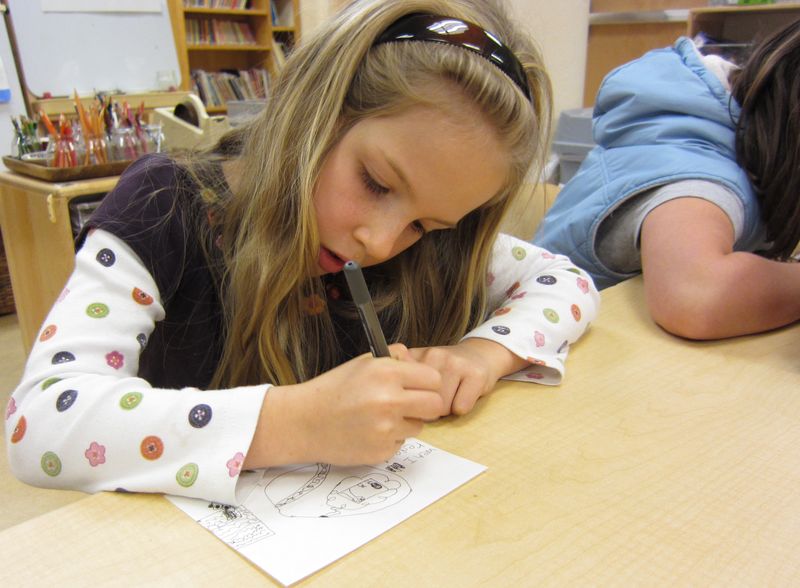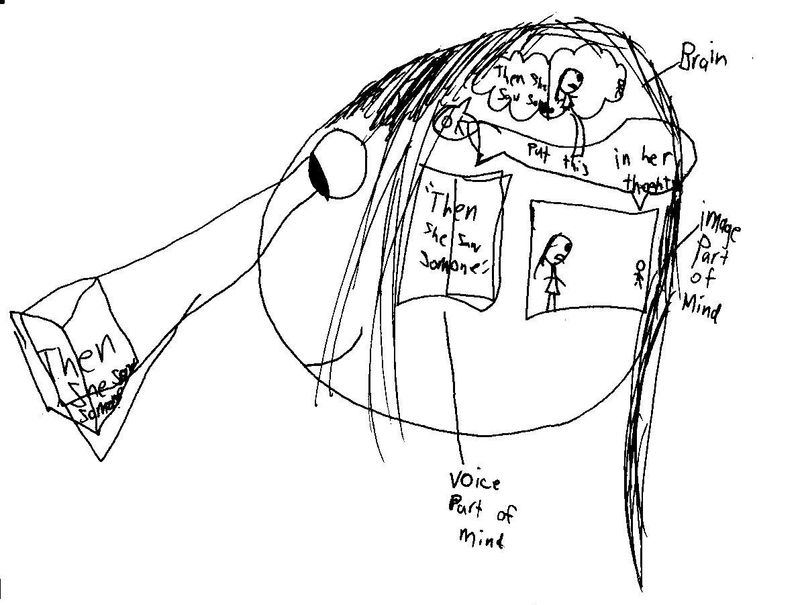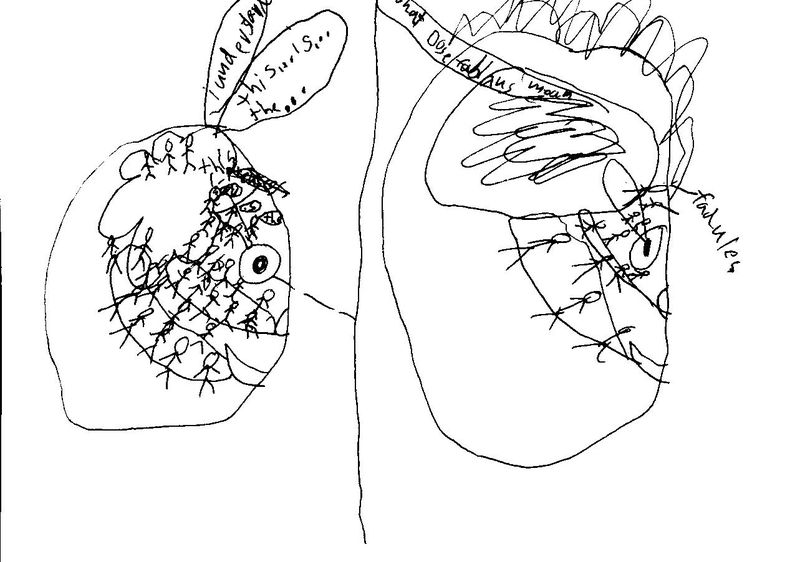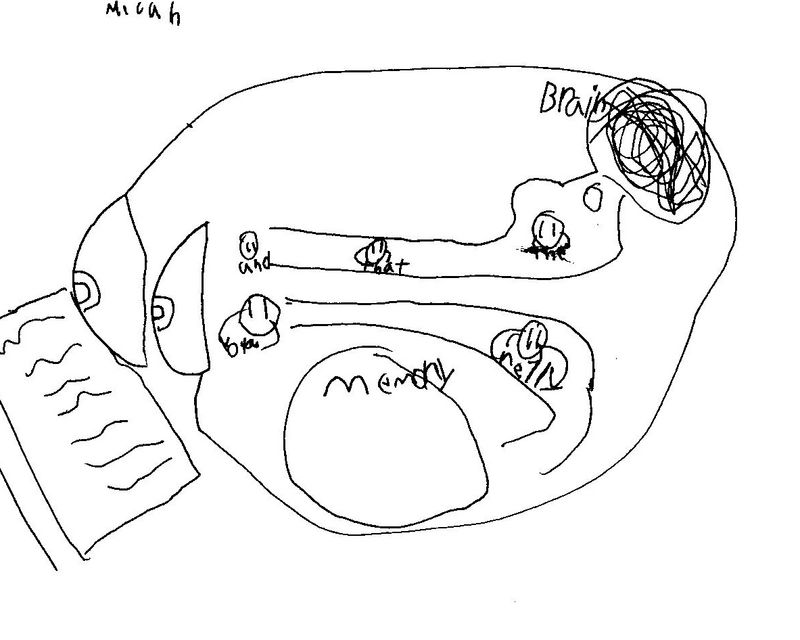Mental Sticky Notes

From Mary Gage Davis, Curriculum Specialist:
In Opal 2, we’ve been paying attention to our thinking as we read and explore comprehension strategies. During a recent read aloud children began to refer to their thinking about reading as “making mental sticky notes.” This idea intrigued me as I wondered how children think reading works. How do the words go from the page to the brain? Where do the ideas for their “mental sticky notes” come from? What do children imagine is happening as they use comprehension strategies, such as making mental images? How might children’s understanding of their own thinking influence their reading comprehension? What are their wonderings?
Just about this time, Marcy began using “science talks” to explore some of the children’s ideas around their terrariums and the creatures living there. (Read Opal 2's post for more information about this project.)
Science Talk: A collaborative exploration of an interest or idea using dialogue to provoke thinking and the child’s capacity to wonder, make hypotheses, build theories, reflect, imagine, intuit, and use personal knowledge.
I wondered what would happen if we gathered children together and used the structure of a science talk to explore some of their theories about reading. So we gathered in a circle and I posed the question, “What do you think happens in our brains and our bodies when we read?”
The following is an excerpt from that initial conversation:
Ezra: It’s like – I’m just gonna add onto Micah’s idea a little bit – like when I see a word, there are many many messengers inside your head, some that are going from your eyes to your brain and your mouth to your brain. They’re circling around and they take messages from the eyes, mouth, the nose, or the ears. And then, for reading, they say what the eyes saw. So, if it’s a word they don’t know, they try to pronounce it, and then if they don’t know the word, then they try to figure it out by reading further or trying out strategies to find out what words they are.
Wrigley: I think that your mind just carries the words that it transports.
Micah: This is when I see a really interesting part. Sometimes the messengers in my brain just read it and tell me what it would be, and sometimes when they think it’s really interesting, they take it to my brain, and then I have the thought still stuck in my brain.
Senan: That’s like a couple years ago, we did this thing about the body – the human body, in Opal 1 – and there were messengers. But we didn’t ever think of the idea of what happens when you read and there’s the messengers. It was more like the hand picks up something and the messengers would tell the brain what the hand picked up.
Amelia: How do the messengers find it out what the other body parts are thinking?
Jackson: Back in Opal 1, I was really thinking about – what I’m really thinking about is does it depend on the brain what the whole body does? Or does every part of the body have to agree about what you’re doing? If your brain threw out your idea about reading, would your whole body have to agree or something?
After the opportunity to build theories together, children were asked to individually draw their current theories, knowing that these theories would continue to change over time, as conversations continued and schema grew.
Messengers travel a certain path to each sense and there is a voice in your brain that says the word. The brain thinks and says either, “I understand” or “I don’t understand.” If you don’t understand the brain stops reading. So then you try somehow to understand the word. Then you keep reading. Sometimes messengers have rest breaks. (Ezra)
If there are lines that means the little cells are going fast to tell the king what is happening in the story. Whenever something interesting happens in the story they (little cells)- they go into the brain from the eyes, mouth and ears. If there is something interesting in the story they tell the king cell- he is in charge and he moves to this places and makes a signal. It makes the brain thing what is going to happen next. (McCune)
Messengers are waiting behind your eyes to wait for you to read. Your messengers can read what your eyes are saying and bring it to your brain. If they’re really interesting (the words) and your brain likes them, the messenger will bring them to the memory and the brain will keep them. (Micah)

There are two parts of your mind. One kind of makes it so you can hear your thoughts. And one has images. When you see words on a page, your images place has an image of what’s happening and your hearing place shows the words that you’re reading and it’s like talking in your mind. (Eliza)
As teachers, it was fascinating to see how the children’s theories reflected the complexity of their thinking, their inspiration and desire to build theories off of one another’s ideas, and their ability to use previous experiences to make meaning of reading (especially those from Opal 1’s Body Project two years ago).
After giving children a week to let these ideas settle and inviting them to really pay attention to what was happening as they read, we asked if anyone would like to come together to for more theory building. Children literally jumped at the opportunity.
Amelia: From our other science talk I’d like to revisit Micah’s idea and I’d like to say again my question, “How do messengers actually get information?”
Wrigley: I think the messengers get information because they can sense the word. They can pick it up from what you see. They’re probably like cells that can pick up information.
Eliza: I don’t think there are messengers. When you read a sentence, does it take a long time to get a picture or right when you read it do you get a picture in your mind?
Jackson: When you start thinking about something the messengers are right next to the brain and they’ll tell it out and does like an idea pop into your mind or something?
Micah: I kind of disagree with Eliza that messengers aren’t real. When you read, I can like read this and my eyes would be like that (looking at the words) and my messengers bring it to my brain.
Eliza: I wasn’t saying they aren’t real. I’m saying I don’t think they’re real. Does it take a long time (to get a picture in your mind)?
Wrigley: They send the information on rays. So like the ray is traveling, instantaneous rays travel to the messenger and the messengers record it and pass it onto the brain.
Amelia: I agree with that theory. So it could be rays, it could be very very fast messengers or there could be no messengers at all. So there are three possibilities. How do we find out?
From here, we as teachers will look for opportunities to explore these ideas further, to invite children to pay attention to what is happening in their brains as they employ new reading strategies, to encourage inquiry about their thinking and to pursue possibilities.
This deep engagement, sense of wonder and sustained curiosity creates the perfect conditions for nurturing lifelong learners. Loris Malaguzzi (the founder of the pre-primary schools of Reggio Emilia) writes, "Once children are helped to perceive themselves as authors and inquirers, their motivation and interest explode."




